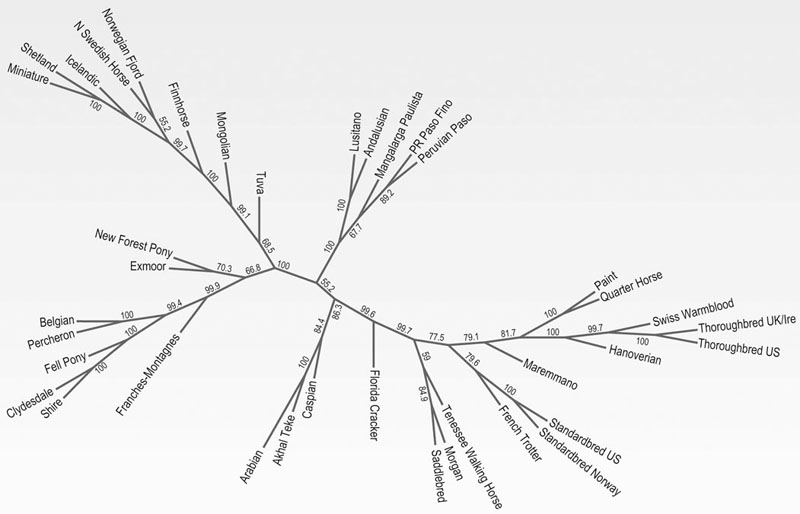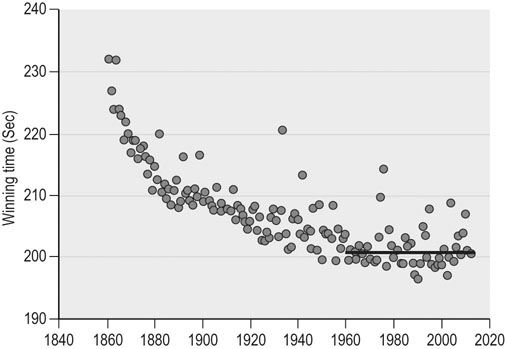The horse is an extraordinary athlete, a characteristic that is the result of the evolution of horses as grazing animals on the ancient prairies of North America. Survival in these open lands was enhanced by speed to escape predators and endurance required to travel long distances in search of feed and water. These attributes are shared by prong horn antelopes (Antilocapra americana), another species that evolved on the prairies,1 as well as black wildebeest (Connochaetes gnou), a South African herbivore.2 The equid characteristics of speed and endurance were subsequently modified or enhanced by selective breeding by humans, resulting in the wide variety of breeds extant today. While ancient horses, such as Eohippus, Mesohippus and Equus ferus, evolved on the prairies of North America, they became extinct in the Americas approximately 12 000 years ago, as did other endemic megafauna.3 It appears that two clades of Equus ferus, the immediate progenitor of the modern horse, existed with one in North America becoming extinct and the other, which had a holartic distribution including Europe, evolving into the modern horse (Equus caballus).3 Horses were returned to the Americas by European explorers, colonizers and missionaries after 1494. Horses were domesticated as early as 4000 BCE (before current era) in Eastern Europe and the Eurasian steppes.4 Archeological evidence of dental lesions consistent with use of a bit or bridle and biochemical evidence of storage of mare’s milk and carcass products in ceramic cooking and food storage utensils provides clear demonstration of domestication of modern horses at this time.4 Analysis of mitochondrial DNA and the Y chromosome of modern horses provides considerable evidence that horses were domesticated on more than one occasion and that this process involved introgression of wild females into the domestic population.5,6 Przewalski’s horse, with a karyotype of 2N = 66 chromosomes, is not a direct progenitor of the modern horse, with 64 chromosomes.7 Analysis of mitochondrial genomes and microsatellite markers provides compelling evidence that modern horses are derived from multiple matrilineal lineages from the extinct Equus ferus.6 The earliest Ancestral Mare Mitogenome, from which all mitochondrial DNA in modern horses derive, is dated at approximately 153 000 years ago.6 There were likely no fewer than 17 founding matrilineal lineages of modern horses, a situation that contrasts with domestication of other livestock species in which the modern population is based on a very small number of female founders.6 In contrast, there is evidence based on analysis of sequence diversity in the Y chromosome of modern horses that only a small number of stallions were foundation stock for modern horses.8 A plausible explanation is that modern horses were domesticated on more than one occasion and likely in the area of the Caspian Sea and, separately, in the geographically distant Iberian Peninsula, both areas of refugia of undomesticated horses during the Holocene when large areas of Europe were covered by dense forest (a habitat unsuitable for horses).9 Domestication was likely achieved by breeding of a small number of founder stallions with both domesticated mares and mares caught from the wild. Societal factors also played a role in domestication of the horse as knowledge of how to do so lead different groups of people to undertake domestication of local horses resulting in multiple matrilineal lines.5 The limited patrilineal lineages of horses could be a result of population bottlenecks or selective breeding to a small number of stallions during the demic spread of domesticated animals. 8 Domesticated horses were selected and bred for certain traits, depending on the intended use, with the result that there are now many hundreds of breeds of horses.10 Large heavy breeds of horses were bred for draft work, such as pulling ploughs, sleds or carts, or military work, such as the chargers that carried heavily armored knights into the battles of the middle ages. Lighter horses were bred for speed and endurance and were used for transportation, herding and sport. Thoroughbred racehorses run at high speed (18 m/s, 64 km/h) over distances of 800 to 5000 meters, Standardbred horses trot or pace at high speed for distances up to 3600 m, Quarter Horses sprint for 400 m or less at speed as high as 88 km/h, sometimes around figure of eight courses delineated by barrels (barrel racing), and Arabians trot or canter at speeds of up to 29 km/h for up to 160 km in a single day during endurance events (and over longer distances during multi-day races). In contrast, draft horses pull huge weights (1000 kg or more) short distances in pulling competitions, Warmbloods perform elegant, but demanding, dressage routines, and ponies pull lightly laden jinkers or buggies. Large scale studies of SNP data from multiple breeds and large numbers of horses reveals the genetic relationships between breeds of horses (Fig. 1.1).11 There is clear genomic evidence that selection has played a strong role in modifying both the genotype and phenotype of horses within breeds. This is best exemplified for Thoroughbred in which the emergence of a single nucleotide polymorphism for the myostatin gene can be clearly traced back to the influence of one or two key stallions. 12The C/C and C/T polymorphisms of the MSTN gene (which encodes myostatin) are, compared to the T/T polymorphism, associated with superior athletic performance by Thoroughbred horses racing over short distances (<1600 m).13 The presence of the C polymorphism was uncommon in Thoroughbreds before 1950 with the T allele being the most common ancestral allele12. The C allele was introduced into the Thoroughbred breed by a single female during the foundation of the breed, but was rare before it proliferated in the breed as a result of the success of offspring of Neartic and his son, Northern Dancer.12 Northern Dancer was the most influential stallion of modern times and the success of his offspring in short to mid-distance races ensured the propagation of the C allele.12 Amongst current Thoroughbred horses used for sprint racing (≤1400 m), over 90% are either C/C or C/T genotype with 70% of the alleles being C, indicating the effect of profound selection pressure for sprint racing on the distribution of this allele, and related genotypes, in Thoroughbreds.12 A large number of physiological and anatomical features act in concert to endow the horse with extraordinary athletic capacity. Maximal athletic performance is dependent upon integrated functioning of these physiological and anatomical features.14,15 However, there are limits to maximal performance of horses, and there is evidence that these limits have been reached or will soon be so, particularly for Thoroughbred and Standardbred racehorses.16–18 The winning times for major Thoroughbred races have not improved significantly since approximately 1970 as is exemplified by the winning times for the Melbourne Cup, a 3200 m (two mile) race run every November in Melbourne, Australia (Fig. 1.2). While it is hypothesized that winning times are a function of the size of the population available to compete in an event, in that the greater the number of animals or people available to compete, the more likely that one individual will excel.16 However, analysis of the population statistics and winning times of Thoroughbred race horses does not provide evidence to support this hypothesis, with the maximal effect of population occurring at fewer than 10 000 horses.16 The reasons for this plateau in winning times of Thoroughbreds is unclear. It might be that selective breeding has had its maximal effect in this closed population of horses originating from a small pool of ancestors and that in the absence of major developments in nutrition, management or health that there is no further genetic potential to increase speed.16 Others disagree with this interpretation and provide evidence that there is sufficient genetic variation within Thoroughbreds to improve performance.19 The recent demonstration that genotype, and in particular a single nucleotide polymorphism (SNP) of the myostatin gene, of Thoroughbreds is associated with race performance provides evidence that there remains the capacity to improve further performance through selection.12 The situation differs somewhat with Standardbreds in which there has been a consistent reduction in race times and pace over recent times.17,18 This improvement is presumably a result of one or more of strong selection pressure, improved training methods, or improved equipment and racing facilities.17 The decrease in race time has been well documented for Swedish and Italian trotters.17,18 The reduction is exponential and appears to be approaching an asymptote, which in 2001 was predicted to occur in 2015 17 but which has not occurred for Italian trotters.18 Regardless of their size, provenance or intended use, all horses have in common an ability to perform physical activities, including running or jumping, at a level that surpasses that of most other animals of similar body size. The concept of body size is important as many physiological variables, and especially the maximum values of these variables, do not scale directly with body weight but often more closely scale to an exponent of body weight.20 Commonly, exponents range between 0.68 and 0.75. This exponent is derived empirically from the measurement of variables such as maximum running speed or maximum rate of oxygen consumption ( Table 1.1 Selected physiological variables of athletic and non-athletic species *During customary athletic activity. Max = maximum value. a = day of racing; b = Tour de France cyclists;
The horse as an athlete
Origins of the horse

Limits to performance

Comparative physiology
 ). Typically, when expressed as a one-to-one function of body weight (i.e. per kg), values for many variables are much higher for smaller mammals. The necessity to allometrically scale variables has fascinating physiological implications and interpretations.20 However, direct comparison among species is to some extent specious from the point of view of depicting differences in physical capacity, given that the absolute values of these variables vary to such a large extent. Nonetheless, such comparisons are frequently made, if only to reinforce the magnitude of the maximal absolute values of these variables in the exercising horse (Table 1.1).
). Typically, when expressed as a one-to-one function of body weight (i.e. per kg), values for many variables are much higher for smaller mammals. The necessity to allometrically scale variables has fascinating physiological implications and interpretations.20 However, direct comparison among species is to some extent specious from the point of view of depicting differences in physical capacity, given that the absolute values of these variables vary to such a large extent. Nonetheless, such comparisons are frequently made, if only to reinforce the magnitude of the maximal absolute values of these variables in the exercising horse (Table 1.1).
SPECIES
BODY WEIGHT (kg)
SPEED* (km/h)
DURATION OF EXERCISE
 (ml O2/kg/min)
(ml O2/kg/min)
HR* (bpm)
ENERGY EXPENDITURE PER DAY (kcal)
Thoroughbred racehorse
450
64 (max)
2 min
180–200
240 (max)
30 000
Endurance racehorse
400
15
180
38 000a
Steer
470
80
Goat
32
Greyhound
34
64 (max)
60 sec
Not reported
300*
2160
Sled dog
25
20
10 days
170
300
11 000
Human (Olympic class)
70
36 (max)
9.4 sec
85
220
7000b
Pronghorn antelope
32
65
10 min
300

![]()
Stay updated, free articles. Join our Telegram channel

Full access? Get Clinical Tree


The horse as an athlete
